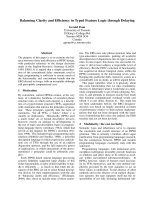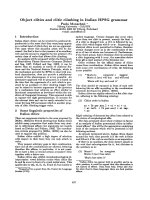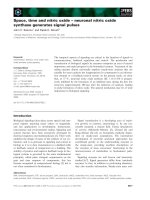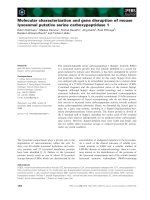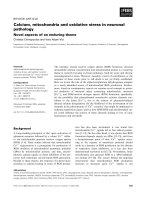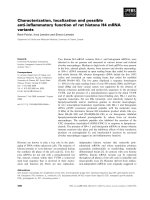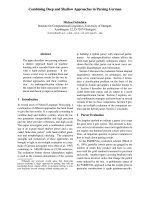Báo cáo khoa học: " Biomass production and stool mortality in hybrid poplar coppiced twice a year" ppt
Bạn đang xem bản rút gọn của tài liệu. Xem và tải ngay bản đầy đủ của tài liệu tại đây (375.25 KB, 7 trang )
Note
Biomass
production
and
stool
mortality
in
hybrid
poplar
coppiced
twice
a
year
D
Auclair
L Bouvarel
1
INRA,
Station
de
Sylviculture;
2
INRA,
Unité
expérimentale
biomasse
forestière
et
forêt
paysanne,
Ardon,
45160
Olivet,
France
(Received
4
October
1990;
accepted
11
March
1992)
Summary —
In
order
to
study
the
effects
of
extremely
short
rotations,
the
growth
of
hybrid
poplar
cuttings
coppiced
biannually
over
a
period
of
4
years,
in
summer
and
in
winter,
was
compared
with
growth
of
cuttings
coppiced
annually
in
winter.
The
biannual
treatment
led
to
a
progressive
decrease
in
height
growth
and
in
total
biomass
production,
and
to
high
stool
mortality.
Some
aspects
of
the
physiology
of
coppicing
are
discussed.
growth
/
coppice
/
short
rotation
/
Populus
Résumé —
Production
de
biomasse
et
mortalité
des
souches de
peuplier
hybride
recépé
deux
fois
par
an.
Des
boutures
de
peuplier
hybride
interaméricain
recépées
deux
fois
par
an
pen-
dant
4
ans
ont
été
comparées
à
des
boutures
recépées
annuellement,
dans
le
but
d’étudier
les
ef-
fets
d’un
stress
physiologique
important
sur
la
croissance
des
rejets
de
taillis.
Le
recépage
bisannuel
a
entraîné
une
forte
mortalité
des
souches
et
une
baisse
de
la
croissance
en
hauteur.
Une
diminu-
tion
de
la
production
de
biomasse
sèche
par
unité
de
surface
peut
être
attribuée
à
la
fois
à
une
baisse
de
production
en
biomasse
des
souches
vivantes
et
à
la
mortalité.
Différents
aspects
du
fonctionnement
des
arbres
traités
en
taillis
sont
discutés.
croissance
/ taillis
/ courte
rotation
/Populus
*
Present
address:
INRA,
Laboratoire
de Recherches
Forestières
Méditerranéennes,
Avenue
A
Vi-
valdi,
84000
Avignon,
France
**
Present
address:
Station
de
Mécanique
Forestière,
Association
Pour
la
Rationalisation
et
la
Méca-
nisation
de
l’Exploitation
Forestière,
45210
Fontenay
sur
Loing,
France
INTRODUCTION
Silviculture
of
coppice,
practised
since
neolithic
times
in
Europe
(Evans,
1984),
utilizes
the
ability
of
many
broad-leaved
trees
to
regenerate
themselves
from
the
cut
stump.
The
early
growth
rate
of
cop-
pice
sprouts
is
much
greater
than
that
of
seedlings
or
cutting
(Lee
et
al,
1987;
Wright,
1988;
Bergez
et al,
1989).
This
very
early
peak
of
biomass
annual
increment,
and
the
increasing
demand
for
woody
raw
matter
for
industrial
and
energy
use
has
induced
foresters
to
decrease
the
length
of
coppice
rotations,
leading
to
the
concept
of
short
rotation
intensive
coppice
(Perlack
et
al,
1986).
The
proposed
short
rotation
usually
ranges
from
5
(Hummel
et
al,
1988)
to
10
years
(Bonduelle,
1990),
compared
to
the
traditional
20-30
years.
Three-year
rotations
are
practised
in
Swe-
den
for
energy
forestry
(Siren
et
al,
1987),
and
traditional
basket-willow
cultivation
(Salix
triandra
and
S
viminalis)
consists
of
1-year
rotations
(Stott,
1956).
It
is
often
speculated
that
rotations
short-
er
than
3
years
would
entail
yield
losses
af-
ter
several
rotations
due
to
physiological
problems,
such
as
’ageing’
of
the
stumps
and
lack
of
carbohydrate
reserves
(Blake
and
Raitanen,
1981;
Ferm
et
al,
1986).
However,
Auclair
and
Bouvarel
(1992a)
showed
that
hybrid
poplar
coppiced
annual-
ly
could
maintain
its
production
for
at
least
6
years.
The
end-product
of
such
very
short
rotations
is
up
to
now
still
marginal,
but
some
1-year
rotation
systems
are
economi-
cally
viable
in
particular
cases.
The
objective
of
the
present
experiment
was
to test
the
possibility
of
pursuing
even
further
the
shortening
of
the
rotation.
After
the
establishment
year,
young
poplars
were
coppiced
twice
a
year
and
their
height
growth
and
biomass
production
were
compared
with
those
coppiced
only
once
a
year.
Total
above-ground
biomass
production
was
analyzed,
including
leaves
which
might
be
of
interest
for
wet
biomass
use,
or
for
fodder.
MATERIAL
AND
METHODS
The
present
experiment
was
part
of
a
larger
pro-
ject
including
different
cutting
cycles
and
planting
densities
(Auclair
and
Bouvarel,
1992a).
One
Populus
trichocarpa
x
deltoides
clone
(Beaupré)
was
planted
in
spring
1983
on
a
converted
wood-
land
on
the
INRA
estate
near
Orléans
(central
France).
Situated
on a
loamy,
gravelly
ancient
terrace
of
the
Loire
river,
the
sandy
acid
soil
has
a
very
low
water
and
nutrient
reserve.
The
tem-
perate
oceanic
climate
is
characterized
by
annual
precipitations
of
600-700
mm,
summer
water
def-
icits,
and
mild
mean
temperatures
(18-21
°C
in
July,
2-4
°C
in
January).
After
harvesting
and
extracting
the
stumps
of
the
previous
crop
(a
mixed
Quercus-Betula-
Castanea
coppice),
the
soil
was
ploughed
and
fertilized
with
phosphate,
and
rye
was
sown
as
an
organic
fertilizer
in
the
autumn
of
1982.
The
rye
was
turned
under
and
the
planting
bed
har-
rowed
in
the
spring
of
1983,
before
planting
the
cuttings.
Six
individual
plots
of
400
cuttings,
30
cm
long
and
1-2
cm
in
diameter,
were
planted
through
plastic
mulch
in
3
randomized
blocks,
at
2.00
x
0.25
m
spacing,
corresponding
to
20
000
cuttings
per
ha. After
the
establishment
year,
3
replications
were
coppiced
annually
(treatment
A),
between
February
and
April,
and
3
replica-
tions
were
coppiced
biannually
(treatment
B)
as
shown
in
table
I.
During
the
first
year,
in
order
to
ensure
fa-
vourable
establishment,
the
biannual
treatment
was
not
coppiced:
both
treatments
followed
the
same
management.
After
1
year,
survival
was
very
high
and
the
few
dead
stools
(2-3%)
were
replaced
by
new
cuttings.
There
were
no
re-
placements
in
later
years.
Management
operations -
irrigation,
fertiliza-
tion,
weed
and
pest
control -
were
identical
to
those
described
by
Auclair and
Bouvarel
(1992b).
For
each
living
stool,
the
height
of
the
tallest
shoot,
called
’stool
dominant
height’,
and
the
’number
of
dominants’
(number
of
shoots
higher
than
75%
of
dominant
height)
were
recorded
at
each
harvest.
In
addition,
stool
dominant
height
of
plants
in
the
annual
treatment
was
recorded
in
July,
to
compare
with
the
biannual
treatment.
The
total
fresh
biomass
produced
by
each
stool
was
determined
at
the
time
of
harvesting,
and
a
sample
of
15-30
stools
per
treatment
was
dried
at
105
°C
to
estimate
dry
woody
biomass.
Leaf
dry
biomass
was
determined
on
the
sample
har-
vested
in
summer,
and
on a
sample
of
15-30
stools
in
September,
before
leaf
fall.
All
statistical
tests
were
performed
at
the
1%
level.
They
were
mainly
restricted
to
t-tests
ap-
plied
to
independent
data
sets
each
year.
There
was
no
border
effect
and
no
block
effect
(Auclair
and
Bouvarel,
1992a),
consequently
the
data
conceming
height
and
number
of
dominants
were
expressed
as
means
for
each
treatment.
They
did
not
include
dead
stools.
Biomass
data,
ex-
pressed
on
a
land
area
basis,
included
all
stools.
RESULTS
AND
DISCUSSION
Stool
mortality
was
quite
high
(10%)
after
the
first
summer
harvest
of
the
biannual
coppice,
whereas
it
was
only
1 %
for
the
annual
treatment
(fig
1).
In
subsequent
years,
mortality
increased
for
both
treat-
ment,
but
it
was
most
severe
for
stools
coppiced
biannually
(32%
in
year
3).
After
4
years
almost
all
stools
in
the
biannual
coppice
had
died,
but
89%
of
the
stools
were
still
alive
in
the
annual
coppice.
Dominant
height
growth
of
living
stools
is
shown
in
figure
2.
Good
growth
was
ob-
served
in
the
first
year
in
which
irrigation
was
applied.
In
subsequent
years,
height
growth
was
slightly
depressed
for
the
an-
nual
treatment,
probably
due
to
dry
sum-
mer
periods:
average
August
rainfall
was
less
than
40
mm
for
a
total
annual
rainfall
of
700
mm.
The
spring
period
contributed
most
to
total
height
growth
of
plants
har-
vested
annually,
confirming
the
results
of
Bergez
et
al
(1989).
In
the
biannual
treatment,
height
growth
progressively
decreased
from
year
2
on-
wards.
For
both
treatments,
shoots
grew
taller
during
the
spring
period
(measured
in
July)
than
after
the
summer
harvest
in
years
2-4
inclusive.
This
was
probably
due
to
the
soil
moisture
deficits
summer.
However,
plants
in
the
biannual
treatment
had
less
height
growth
during
the
spring
period,
compared
to
plants
in
the
annual
treatment
in
years
3
and
4.
Differences
be-
tween
treatments
for
height
growth
were
all
statistically
significant
from
year
2
on-
wards.
The
number
of
dominant
shoots
per
stool
was
very
large
(average
of
5.5,
rang-
ing
from
1-63)
in
July
of
year
2.
It
then
de-
creased
to
1.6
shoots
per
stool
in
the
an-
nual
treatment
(fig
3):
clearly
competition
within
stools
led
to
a
very
strong
selection
of
shoots,
and
only
1-5
were
dominant
at
the
end
of
the
second
growing
season.
This
was
due
mainly
to
the
fact
that
few
shoots
produced
much
height
growth
after
July;
those
which
did
became
dominant.
There
was
little
mortality
of
the
shoots
by
the
end
of
the
growing
season.
The
num-
ber
of
dominants
increased
slightly
each
year
for
the
annual
treatment.
From
year
2
until
the
end
of
the
experi-
ment,
when
most
stools
were
dead,
stools
in
the
biannual
treatment
produced
signifi-
cantly
larger
numbers
of
dominants
than
those
in
the
annual
treatment,
both
in
sum-
mer
and
in
winter.
The
larger
number
of
dominants
in
the
biannual
coppice
than
in
the
annual
coppice
can
be
attributed
to
the
lack
of
competition
between
shoots
from
the
same
stool
during
the
first
period
of
growth.
Competition
began
only
after
July
in
the
annual
treatment,
when
a
small
number
of
favoured
shoots
dominated
the
others.
In
the
biannual
treatment,
competi-
tion
was
not
great
enough
to
induce
such
a
selection.
Total
above-ground
production
(leaf
bio-
mass
plus
wood
biomass)
was
380
g.m
-2
in
the
first
year,
when
both
treatments
had
a
single
winter
harvest.
Each
treatment
pro-
duced
approximately
250
g
of
wood
and
130
g
of
leaves
per
square
metre
(fig
4).
In
years
2-4,
the
annual
treatment
pro-
duced
less
biomass
than
in
the
first
year,
a
result
highlighting
the
positive
effect
of
irri-
gation
in
year
1,
in
contrast
to
the
dry
con-
ditions
prevailing
during
summer
in
subse-
quent
years
(Auclair
and
Bouvarel,
1992a).
Leaves
accounted
for
about
35%
of
total
biomass.
Biannual
coppicing
severely
decreased
total
production.
The
winter
harvest
only
yielded
20%
of
total
annual
biomass
pro-
duction.
Leaves
accounted
for
over
50%
of
total
biomass.
Total
biomass
production
of
the
biannual
treatment
was
78%
of
the
pro-
duction
of
the
annual
treatment
in
the
sec-
ond
year,
26%
in
the
third
year,
and
5%
in
the
fourth
year.
Differences
between
treat-
ments
were
all
statistically
significant
from
the
second
year
onwards.
It
is
interesting
to
note
the
relative
contri-
bution
of
stool
mortality
and
of
individual
stool
biomass
to
the
decrease
in
production
of
the
biannual
treatment
compared
to
the
annual
treatment
(table
II).
Total
dry
woody
biomass
produced
each
year
by
living
stools
decreased
in
the
biannual
treatment
compared
to
the
annual
treatment.
The
de-
crease
in
total
woody
biomass
expressed
on an
area
basis
was
even
greater
because
of
stool
mortality
in
the
biannual
treatment.
It
should
be
noted
that
growth
ceased
in
mid-September
for
the
annual
treatment,
but
continued
for
another
2
weeks
in
the
biannual
treatment.
This
was,
however,
in-
sufficient
to
ensure
a
sustained
production,
and
biomass
production
after
the
summer
harvest
was
very
low.
This
may
be
attribut-
ed
to
dry
summer
conditions
which
inhibit-
ed
growth
of
the
young
sprouts.
It
is
possi-
ble
that
the
observed
decrease
in
total
annual
production
was
caused
by
a
deple-
tion
of
stump
reserves
which
would
be
uti-
lized
for
both
the
spring
and
the
summer
budbreaks,
and
which
could
not
be
re-
placed
during
the
summer
period
(Dubro-
ca,
1983;
Pontailler
et al,
1984).
CONCLUSION
The
aim
of
the
present
experiment
was
to
study
the
possibility
of
coppicing
trees
with
an
extremely
disturbing
biannual
cycle.
The
results
clearly
showed
a
decrease
in
biomass
production
and
an
increase
in
stool
mortality
in
the
biannual
coppicing
treatment.
In
the
absence
of
physiological
studies
on
the
present
material,
we
can
only
spec-
ulate
on
some
aspects
of
the
underlying
physiology
of
coppiced
trees.
Summer
har-
vests
probably
enhanced
the
coppicing
stress
by
a
loss
of
leaf
area,
preventing
the
buildup
of
carbohydrate
reserves
in
the
roots.
For
further
physiological
studies,
a
sustained
production
could
probably
be
obtained
with
additional
irrigation
and
fertilization,
although
it
would
be
uneco-
nomical
for
pratical
use.
An
analysis
of
root
growth,
such
as
that
which
was
started
by
Bédéneau
and
Auclair
(1989)
using
soil
cores,
or
by
using
root
growth
chambers,
could
provide
precious
information
on
root-shoot
relations
in
coppice.
Below-ground
and
above-ground
carbohydrate
content,
the
pathways
by
which
such
reserves
are
built,
and
their
allocation,
water-use
and
nutrient
uptake
studies,
such
as
those
performed
by
Tschaplinski
and
Blake
(1989a,
1989b),
could
be
undertaken
on
experimental
material
such
as
ours,
with
different
growth
conditions,
and
should
provide
much
information
on
the
physiology
of
trees
coppiced
at
more
traditional
rota-
tions.
ACKNOWLEDGMENTS
This
research
was
partly
funded
by
the
French
Energy
Management
Agency
(AFME).
We
are grateful
to
JD
Isebrands,
RE
Dickson,
And JD
Deans
for
their
helpful
comments
on the first
version
of
the
manuscript.
We
particularly
wish
to
thank
the
technical
staff
of
the
Orléans
silviculture
and
biomass
laborato-
ries.
REFERENCES
Auclair
D,
Bouvarel
L
(1992a)
Influence
of
spac-
ing
and
short
rotations
on
Populus
trichocar-
pa
x
deltoides
coppice.
Can
J
For
Res
22
(in
press)
Auclair
D,
Bouvarel
L
(1992b)
Intensive
or
ex-
tensive
cultivation
of
short
rotation
hybrid
poplar
coppice
on
forest
land.
Bioresource
Technol 42
(in
press)
Bédéneau
M,
Auclair
D
(1989)
Effect
of
coppic-
ing
on
hybrid
poplar
fine
root
dynamics.
Ann
Sci
For 46
suppl,
294s-296s
Bergez
JE,
Auclair
D,
Bouvarel
L
(1989)
First-year
growth
of
hybrid
poplar
shoots
from
cutting
or
coppice
origin.
For
Sci
35, 1105-1113
Blake
TJ,
Raitanen
WE
(1981) A
Summary
of
Factors
Influencing
Coppicing.
IEA
Rep
NE-
1981:22,
Nat
Swedish
Board
for
Energy
Source
Dev,
Stockholm,
24
p
Bonduelle
P
(1990)
Intensive
cultivation
of tim-
ber
in
short
rotations.
In:
Biomass
for
Energy
and
Industry.
5th
EC
Conference
(Grassi
G,
Gosse
G,
dos
Santos
G,
eds)
Elsevier
Appl
Sci,
London,
1148-1154
Dubroca
E
(1983)
Évolution
saisonnière
des
ré-
serves
dans
un
taillis
de
châtaigniers,
Cas-
tanea
sativa
Mill,
avant
et
après
la
coupe.
Thesis,
Univ
Paris-Sud,
209
p
Evans
J
(1984)
Silviculture
of
Broadleaved
Woodland.
For
Comm
Bull
62,
Her
Majesty’s
Stationery
Office,
London,
232
p
Ferm
A,
Kauppi
A,
Rinne
P
(1986)
Develop-
ing the
coppicing
potential
of
selected
hardwoods
in
biomass
energy
production.
In:
Research
in
Forestry
for
Energy
(Mitchell
CP,
Nilsson
PO,
Zsuffa
L,
eds)
Swed
Univ
Agric
Sci
Garpenberg,
Rep
49, 100-106
Hummel
FC,
Palz
W,
Grassi
G
(eds)
(1988)
Biomass
Forestry
in
Europe:
A
Strategy
for the
Future.
Elsevier
Appl
Sci,
London,
600
p
Lee
DK,
Gordon
JC,
Promnitz
LC
(1987)
Three-
year
growth
and
yield
of
Populus
hybrids
grown
under
intensive
culture.
Biomass
13,
117-124
Perlack
RD,
Ranney
JW,
Barron
WF,
Cushman
JH,
Trimble
JL
(1986)
Short
rotation
intensive
culture
for
the
production
of
energy
feed-
stocks
in
the
US:
a
review
of
experimental
re-
sults
and
remaining
obstacles
to
commercial-
ization.
Biomass
9, 145-159
Pontailler
JY,
Leroux
M,
Saugier
B
(1984)
Évolu-
tion
d’un
taillis
de
châtaigniers
avant
la
coupe :
photosynthèse
et
croissance
des
re-
jets.
Acta
Oecol Oecol
Appl 5,
89-99
Siren
G,
Sennerby-Forsse
L,
Ledin
S
(1987)
En-
ergy
plantations-short
rotation
forestry
in
Sweden.
In:
Biomass -
Regenerable
Energy
(Hall
DO,
Overend
RP,
eds)
John
Wiley
and
Sons,
New
York,
119-143
Stott
KG
(1956)
Cultivation
and
uses
of
basket
willows.
Quart
J For
14
Tschaplinski
TJ,
Blake
TJ
(1989a)
Photosynthet-
ic
reinvigoration
of
leaves
following
shoot
de-
capitation
and
accelerated
growth
of
coppice
shoots.
Physiol
Plant 75,
157-165
Tschaplinski
TJ,
Blake
TJ
(1989b)
The
role
of
sink
demand
in
carbon
partitioning
and
pho-
tosynthetic
reinvigoration
following
shoot
de-
capitation.
Physiol
Plant 75,
166-173
Wright
LL
(1988)
Are
increased
yields
in
cop-
pice
systems
a
myth?
Bull
Finn
For
Res
Inst
304, 51-65
